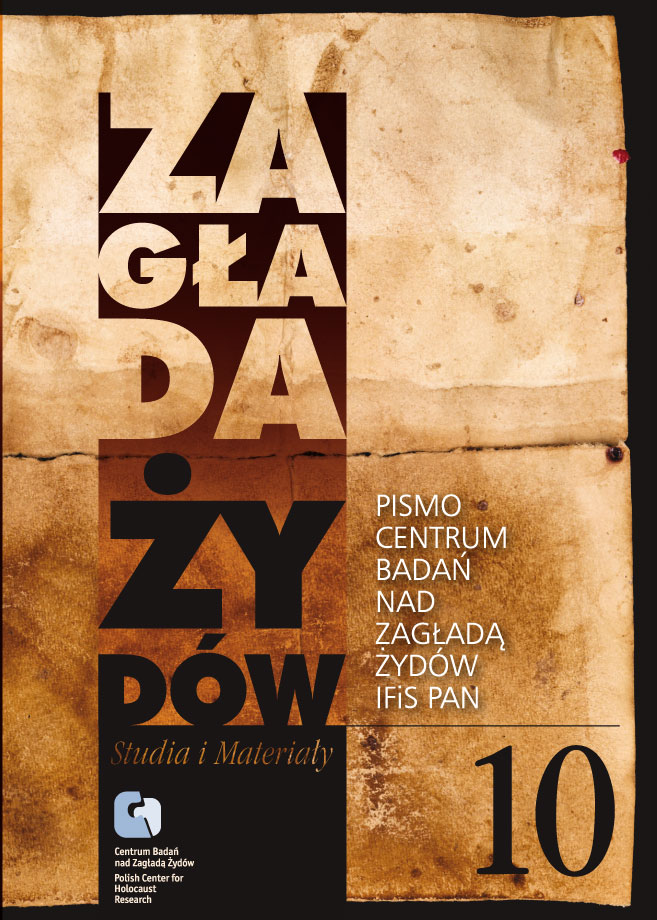Krzesiny i Kreising – między pamiętaniem a pomijaniem. Polskie miasteczko wobec historii, pamięci i rywalizacji w cierpieniu
Zagłada Żydów. Studia i Materiały, Nr 10 (2014), Strony: 443-461
Data zgłoszenia: 2020-10-22Data publikacji: 2014-12-01
 https://doi.org/10.32927/ZZSiM.532
https://doi.org/10.32927/ZZSiM.532
Abstrakt
The area around Krzesiny, located near the city of Poznań, Poland, witnessed several dark events during World War II: Germans oppressed the local population, culminating in a terrorizing action dubbed “akcja krzesińska;” also, a forced labor camp, named “Kreising,” was built near the township, housing mainly Jews. After the war, the suffering in Krzesiny was remembered, but selectively – “akcja” and other forms of Polish suffering were commemorated, while the camp was not. By exploring the “lieux de mémoire” in Krzesiny – dynamics of memory in a small township in Poland – this paper uses localized research to address the issue of gaps in collective memory and commemoration. We briefly look at the relevant history, Polish memory regarding wartime events in Krzesiny, and the postwar dynamics of collective memory. Discussing the latter, we identify a new phenomenon at work, one which we dub “collective disregard” – group neglect of the past of the “Other” that occurs without clear intent. We argue that “collective disregard” is an issue that naturally occurs in the dynamics of memory. By making a deliberate investment in balanced remembrance and commemoration, societies can counter the tendencies of “disregard” and curb the controversies of competitive victimization claims, also called “competitive martyrdom”.
Licencja
Prawa autorskie (c) 2014 Autor & "Zagłada Żydów. Studia i Materiały"

Utwór dostępny jest na licencji Creative Commons Uznanie autorstwa 4.0 Międzynarodowe.
https://creativecommons.org/licenses/by/4.0
Podobne artykuły
- Krzysztof Czubaszek, Stanisław Żemis – świadek zagłady Żydów w Łukowie , Zagłada Żydów. Studia i Materiały: Nr 14 (2018)
- Andrzej Żbikowski, Goetz Aly, Hitlers Volksstaat. Raub, Rassenkrieg und nationaler Sozialismus , Zagłada Żydów. Studia i Materiały: Nr 1 (2005)
- Ariko Kato, Recepcja Holokaustu w Japonii w perspektywie porównawczej: Auschwitz –Nankin – Hiroszima , Zagłada Żydów. Studia i Materiały: Nr 13 (2017)
- Jakub Muchowski, Rafał Lemkin i historia powszechna ludobójstw , Zagłada Żydów. Studia i Materiały: Nr 18 (2022)
- Monika Adamczyk-Garbowska, Trzy wizyty w Auschwitz , Zagłada Żydów. Studia i Materiały: Nr 14 (2018)
- Marcin Przegiętka, Co o Zagładzie wiedział Adolf Gerteis, prezes Kolei Wschodniej? , Zagłada Żydów. Studia i Materiały: Nr 20 (2024)
- Adam Kopciowski, Robert Kuwałek, Relacja żony Leona Feldhendlera , Zagłada Żydów. Studia i Materiały: Nr 7 (2011)
- Jan Borowicz, Agnieszka Dauksza, Klub Auschwitz. Rwane opowieści przeżywców , Zagłada Żydów. Studia i Materiały: Nr 13 (2017)
- Agnieszka Witkowska-Krych, Joanna Beata Michlic, Piętno Zagłady. Wojenna i powojenna historia oraz pamięć żydowskich dzieci ocalałych w Polsce [Agnieszka Witkowska-Krych] , Zagłada Żydów. Studia i Materiały: Nr 17 (2021)
- Martyna Grądzka-Rejak, Joanna Sliwa, Jewish Childhood in Kraków: A Microhistory of the Holocaust , Zagłada Żydów. Studia i Materiały: Nr 20 (2024)
<< < 1 2 3 4 5 6 7 8 9 10 11 12 13 14 15 16 17 18 19 20 21 22 23 24 25 26 27 28 29 30 31 32 > >>
Możesz również Rozpocznij zaawansowane wyszukiwanie podobieństw dla tego artykułu.
 English
English
 Język Polski
Język Polski








